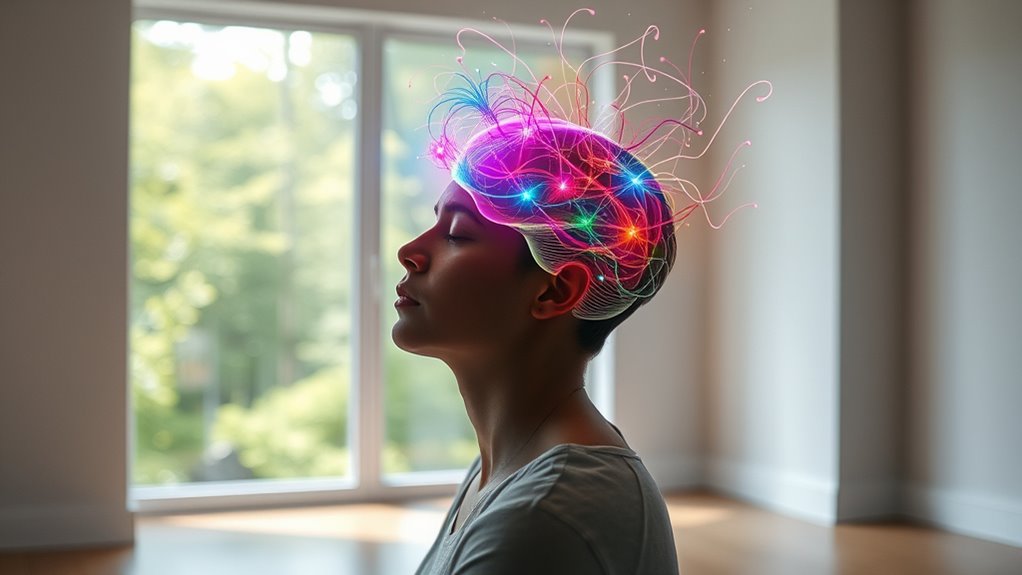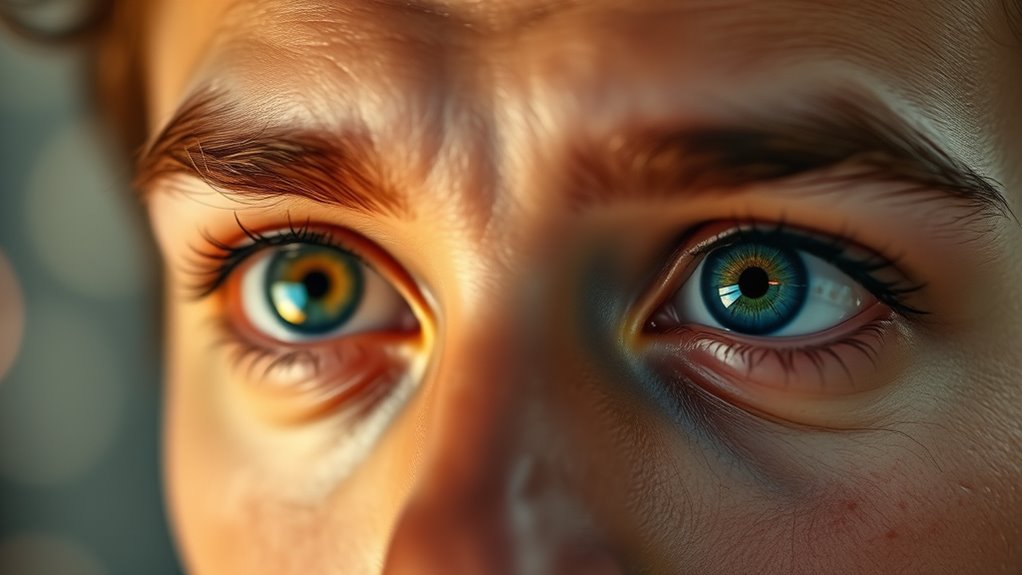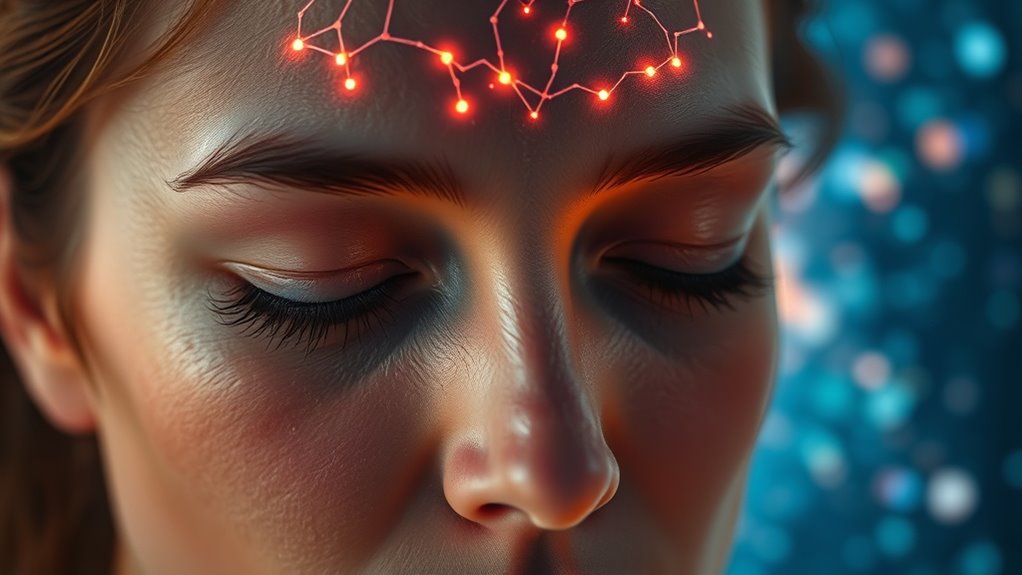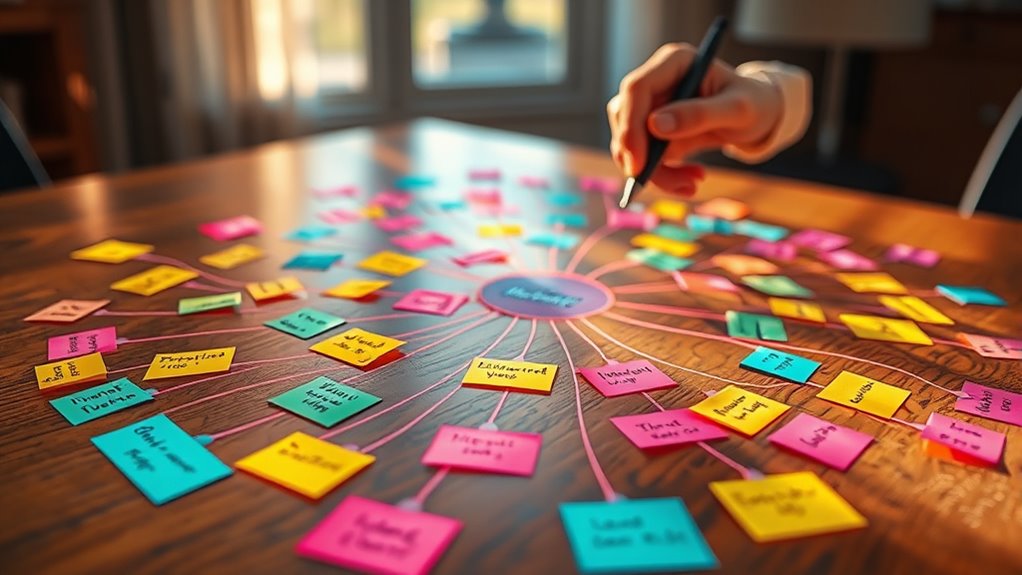Yes, visualization can rewire your brain by strengthening neural connections involved in skills, emotions, and habits. When you vividly imagine success or specific actions repeatedly, your brain forms new pathways and improves communication between regions. This process, supported by neural plasticity, makes skills easier to perform and emotional responses more manageable. Keep exploring to discover how these techniques can help you achieve your desired outcomes more effectively.
Key Takeaways
- Visualization activates neural pathways similar to physical practice, promoting neural rewiring and skill development.
- Repeated mental imagery strengthens neural connections, enhancing brain efficiency and emotional regulation.
- Neural plasticity allows visualization to induce structural brain changes over time.
- Guided imagery and consistent practice reinforce neural networks, supporting long-term brain rewiring.
- Visualization fosters mental resilience and emotional stability by rewiring neural circuits involved in stress and focus.
The Science Behind Visualization and Neural Plasticity

Understanding how visualization impacts your brain begins with neural plasticity—the brain’s remarkable ability to reorganize itself by forming new connections. When you visualize, you’re actively creating and strengthening neural pathways associated with specific thoughts or skills. This process, called cognitive reprogramming, allows your brain to adapt and change based on mental practice rather than physical action alone. As you repeatedly imagine scenarios or outcomes, these neural pathways become more efficient, making it easier to access and execute related behaviors in real life. This neuroplasticity demonstrates that your brain isn’t fixed; it’s flexible and responsive to your mental input. By harnessing visualization, you can reshape your neural networks, paving the way for improved habits, skills, and overall mental agility. Moreover, understanding the AI bifurcation can inspire innovative mental training techniques that leverage both human creativity and artificial intelligence to enhance neural adaptability.
How Athletes Use Mental Imagery to Improve Performance

Athletes use mental imagery to sharpen their skills and perform with greater confidence. By visualizing success, you can reduce anxiety and stay focused under pressure. This practice also helps build mental resilience, so you bounce back quickly from setbacks. Incorporating mindfulness techniques into visualization can deepen the mental rehearsal and enhance overall effectiveness.
Enhancing Skill Acquisition
When athletes vividly imagine executing their skills, their brains activate the same neural pathways involved in actual performance. This mental rehearsal strengthens muscle memory and accelerates skill acquisition. Incorporating mindful meditation helps you stay present during visualization, sharpening focus and reducing distractions. As you practice mental imagery, you also improve emotional regulation, allowing you to stay calm and confident under pressure. By consistently engaging in vivid visualization, you reinforce neural connections that make executing skills feel more natural. This process not only enhances physical ability but also builds mental resilience, making it easier to learn complex movements. The combination of mental imagery, mindfulness, and emotional regulation creates a powerful tool for mastering new skills and refining existing ones efficiently. Additionally, understanding how neuroplasticity influences brain rewiring can optimize your mental training strategies.
Reducing Performance Anxiety
Mental imagery doesn’t just sharpen skills; it also helps calm nerves and reduce performance anxiety. By visualizing successful outcomes, you can create a sense of familiarity and confidence, easing the fear of failure. Incorporating mindfulness meditation into your routine enhances emotional regulation, allowing you to stay centered under pressure. Focused imagery helps you recognize and manage anxious thoughts, preventing them from overwhelming your performance. When you practice calming visualizations, you train your brain to respond with composure rather than panic. This mental preparation fosters resilience, enabling you to handle stress more effectively during high-stakes moments. Ultimately, combining mental imagery with mindfulness techniques equips you with tools to stay calm, focused, and in control when it matters most.
Building Mental Resilience
Building mental resilience is essential for peak performance, and many athletes harness the power of mental imagery to strengthen their minds. Visualization helps you develop emotional regulation, enabling you to stay calm under pressure. Incorporating mindfulness meditation into your routine enhances this process, fostering present-moment awareness and reducing stress. When you vividly imagine challenging situations, you prepare yourself mentally to handle them effectively, building confidence and adaptability. This mental rehearsal strengthens neural pathways associated with focus and emotional control. By consistently practicing visualization combined with mindfulness, you can bounce back faster from setbacks and maintain consistency during competitions. Additionally, understanding beauty hours today list can help you plan your routines effectively, ensuring you have ample time for self-care and mental training. Building resilience through mental imagery isn’t just about mental toughness; it’s about cultivating a resilient mindset that sustains you through adversity.
The Brain’s Response to Visualization: What Neuroscience Reveals

Neuroscience has uncovered that visualization activates many of the same brain regions involved in actual physical performance, effectively rewiring neural pathways. When you vividly imagine success or specific actions, your brain responds as if you’re actually performing them, strengthening neural connections related to those tasks. This process promotes cognitive enhancement by optimizing pathways responsible for skills like focus, memory, and decision-making. Repeated visualization can lead to more efficient neural communication, making actions feel more automatic and reducing mental effort. Your brain’s plasticity allows these mental rehearsals to shape its structure, improving your ability to perform under pressure. Additionally, integrating automation technologies into training routines can further accelerate skill acquisition and reinforce neural pathways. Fundamentally, visualization doesn’t just influence your thoughts; it physically rewires your brain, boosting your capacity for achievement through targeted neural adaptation.
Techniques for Effective Visualization Practice

To make your visualization practice more effective, try guided imagery exercises that help you create vivid mental images. Consistent practice is key, so set aside dedicated time each day to reinforce your neural rewiring. By sticking to these strategies, you’ll strengthen your ability to harness visualization’s full potential, much like how predictive modeling leverages data analysis to optimize educational outcomes.
Guided Imagery Exercises
Guided imagery exercises are powerful tools that help you harness the brain’s plasticity by creating vivid mental scenes. When you engage in these exercises, you can improve emotional regulation by visualizing calming environments or positive outcomes, reducing stress and anxiety. They also boost creativity enhancement by encouraging your mind to explore new ideas and solutions within your mental imagery. To practice effectively, find a quiet space, breathe deeply, and follow a guided script or recording that directs your focus. Concentrate on sensory details—what you see, hear, and feel—to deepen the experience. Regularly practicing guided imagery strengthens neural pathways associated with emotional balance and innovative thinking, making it easier to access these states in real-life situations. Additionally, incorporating mindfulness techniques into your visualization practice can further enhance mental clarity and emotional resilience.
Consistent Practice Strategies
Establishing a regular routine is essential for maximizing the benefits of visualization. Consistent practice helps reinforce neural pathways and deepens your focus. Incorporate brief sessions of mindfulness meditation or creative visualization daily to build momentum. To stay committed, consider the following strategies:
| Technique | Description | Benefits |
|---|---|---|
| Scheduled Sessions | Set specific times each day | Builds habit |
| Mindfulness Meditation | Focus on present moment awareness | Enhances concentration |
| Creative Visualization | Imagine detailed, positive outcomes | Boosts mental clarity |
| Regular Maintenance | Ensure appliances are properly tested and compatible to prevent issues | Maintains safety and efficiency |
Limitations and Criticisms of Visualization Strategies

Despite its popularity, visualization has notable limitations, and critics argue it isn’t a one-size-fits-all solution. Ethical considerations come into play if you rely solely on visualization, especially when it leads to neglecting real-world effort or undermining tangible action. Cultural differences also influence how effective visualization can be; what resonates in one culture might not in another, affecting your engagement and outcomes. Some skeptics point out that visualization alone can create false hope or complacency if not combined with practical steps. Additionally, individual differences in imagination and mental imagery mean it won’t work equally for everyone. Recognizing these limitations helps you stay realistic about what visualization can achieve, ensuring you use it as a complementary tool rather than a sole method for success. Moreover, understanding the benefits of curiosity can encourage a more balanced approach that combines mental visualization with active exploration and learning.
Case Studies: Success Stories and Scientific Findings

Numerous scientific studies and real-life success stories highlight the powerful impact of visualization on achieving goals. For example, research shows that combining visualization with mindfulness meditation enhances emotional regulation, helping individuals manage stress and stay focused. One case study involved athletes who visualized their performance daily; they experienced measurable improvements in confidence and outcomes. Scientific findings reveal that visualization activates brain regions similar to those used in actual experiences, rewiring neural pathways. This process boosts emotional resilience and clarity, making it easier to stay motivated. Additionally, studies suggest that energetic alignment plays a crucial role in amplifying the effectiveness of visualization, allowing individuals to manifest their desires more readily. These success stories demonstrate that consistent mental imagery can lead to tangible results, underscoring visualization’s role in rewiring your brain for success and emotional balance.
Practical Tips for Incorporating Visualization Into Daily Life

Integrating visualization into your daily routine is simple and highly effective when approached intentionally. First, set aside a few minutes each day to practice. Find a quiet space where you won’t be disturbed. Remember, visualization myths can lead you to believe it’s only about imagining success; instead, focus on the emotional impact of your visualization. Feel the joy, confidence, or calmness as if it’s already happening. Keep your images vivid and specific to strengthen neural connections. Avoid overcomplicating the process—consistency matters more than duration. Use simple cues or triggers, like deep breaths or a specific time of day, to build a habit. With patience, this practice rewires your brain, boosting motivation and emotional resilience over time.
Future Directions in Brain-Training and Mental Rehearsal

As technology advances, the future of brain-training and mental rehearsal looks increasingly promising, offering personalized and immersive approaches that could revolutionize how you enhance cognitive and emotional skills. Dream journaling may become integrated into mental exercises, helping you analyze subconscious patterns and improve self-awareness. Innovations could also focus on emotional regulation, enabling you to use visualization techniques to manage stress and strengthen resilience. Virtual reality and neurofeedback might tailor training sessions to your specific needs, making mental rehearsal more effective than ever. These developments promise to liberate new potentials for rewiring your brain, allowing you to harness visualization not just for performance, but for deep emotional growth and self-understanding.
Understanding the Mind-Body Connection Through Visualization

Advancements in brain-training techniques are revealing how powerful visualization can be in shaping both mind and body. When you vividly imagine positive outcomes, you activate neural pathways that support emotional regulation, helping you manage stress and improve mood. This mental practice reinforces habits by pairing visualization with real-world actions, making behavior change more sustainable. As you repeatedly picture successful responses, your brain rewires itself, strengthening connections that promote healthier habits. Visualization doesn’t just influence thoughts—it creates a direct link between your mind and body, enhancing your ability to regulate emotions and develop new routines. By consciously engaging in mental imagery, you harness the mind-body connection, paving the way for lasting change and improved well-being.
Frequently Asked Questions
Can Visualization Help With Mental Health Issues Like Anxiety or Depression?
Visualization can be a helpful tool for managing mental health issues like anxiety or depression. By practicing visualization alongside mindfulness meditation, you can improve emotional regulation and reduce stress. It allows you to reframe negative thoughts and imagine positive outcomes, which can boost your mood and resilience. While it’s not a cure, integrating visualization into your routine offers a proactive way to support your mental well-being and build healthier thought patterns.
Are There Any Risks Associated With Overusing Visualization Techniques?
You might wonder if overusing visualization techniques poses risks. While generally helpful, excessive reliance could lead to risk factors like ignoring real-world action or creating false expectations. Overuse consequences can include frustration if visualizations don’t match reality or mental fatigue from constant mental effort. It’s essential to balance visualization with practical steps, ensuring it remains a supportive tool rather than a distraction or source of disappointment.
How Long Does It Typically Take to See Measurable Brain Changes From Visualization?
You might wonder how long it takes to see measurable brain changes from visualization. With consistent mental rehearsal, you can tap into neural plasticity, which allows your brain to adapt and rewire itself. Typically, noticeable changes can occur within a few weeks to a couple of months, depending on your practice frequency and intensity. Keep practicing regularly, and your brain’s adaptability will work in your favor to strengthen neural pathways.
Is Visualization Equally Effective for Children and Older Adults?
You wonder if visualization works equally well for children and older adults. Developmental differences mean that younger brains are more adaptable, so visualization can be more effective in children. In older adults, age-related effectiveness varies, but visualization still offers benefits by stimulating neural pathways. While the impact may differ due to age-related factors, consistent practice can enhance outcomes across all ages, making it a versatile tool for brain health.
Can Visualization Replace Physical Practice or Training Entirely?
You might wonder if visualization can replace physical practice entirely. While mental rehearsal boosts skill acquisition and helps reinforce neural pathways, it can’t fully replace hands-on training. Physical practice is essential for developing muscle memory and fine-tuning movements. Visualization complements real practice, making your learning more efficient, but for complete mastery, you need both mental rehearsal and physical experience.
Conclusion
As you explore the power of visualization, remember that your mind holds untapped potential. With consistent practice, you might just rewire your brain in ways you never imagined. But the true question is—how far can your mental imagery take you? The answers lie beyond what you see now, waiting silently in the depths of your subconscious. Are you ready to unleash that hidden power and shape your future? The journey begins with a single visualization.










